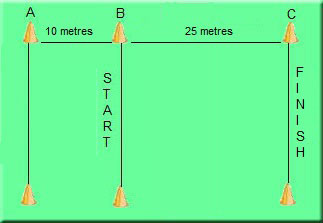

Leg Strength Test
Testing and measurement are the means of collecting information upon which subsequent performance evaluations and decisions are made. In the analysis, we need to bear in mind the factors influencing the results.
Objective
To monitor the development of the athlete's elastic leg strength.
Required Resources
To conduct this test, you will require:
- Flat non-slip surface.
- Cones.
- Stopwatch.
- Assistant.
How to conduct the test
The test requires the athlete to hop 25 metres as fast as possible.
- The athlete warms up for 10 minutes.
- The assistant, using cones, marks out a 25-metre section.
- The athlete starts at cone A.
- The athlete uses a jog run-up to the start line cone (B) and then hops the 25-metre section to the finish line (C) on the right leg as fast as possible.
- The assistant starts the stopwatch when the athlete reaches the start line cone (B) and stops the stopwatch when the athlete completes the 25-metre section (cone C).
- The assistant records the time.
- The athlete repeats the test hopping on the left leg.
- The assistant calculates and records the average of the two recorded times and uses this value to assess the athlete's performance.

Analysis
Analysis of the test result compares it with the athlete's previous results for this test. It is expected that, with appropriate training between each test, the analysis would indicate an improvement in the athlete's leg strength.
Target Group
This test is suitable for active individuals but not for those where the test would be contraindicated.
Reliability
Test reliability refers to how a test is consistent and stable in measuring what it is intended to measure. Reliability will depend upon how strictly the test is conducted and the individual's level of motivation to perform the test. The following link provides various factors influencing the results and test reliability.
Validity
Test validity refers to the degree to which the test measures what it claims to measure and the extent to which inferences, conclusions, and decisions made based on test scores are appropriate and meaningful. This test provides a means to monitor training on the athlete's physical development.
Advantages
- Minimal equipment is required.
- Simple to set up and conduct.
- It can be conducted almost anywhere.
Disadvantages
- An assistant is required to administer the test.
References
- CHU, D.A. (1996) Explosive Power and Strength. Champaign: Human Kinetics
Page Reference
If you quote information from this page in your work, then the reference for this page is:
- MACKENZIE, B. (1997) Leg Test [WWW] Available from: https://www.brianmac.co.uk/legtest.htm [Accessed